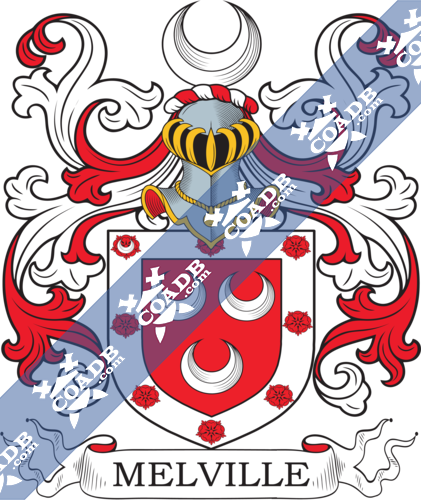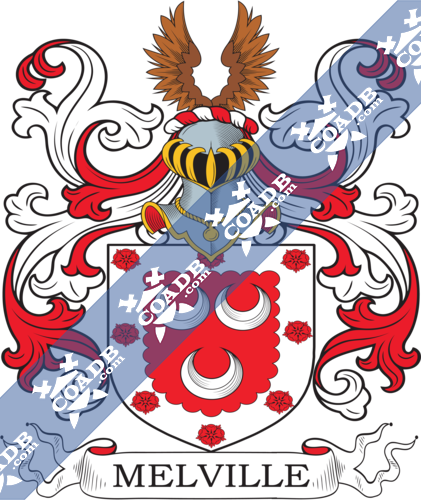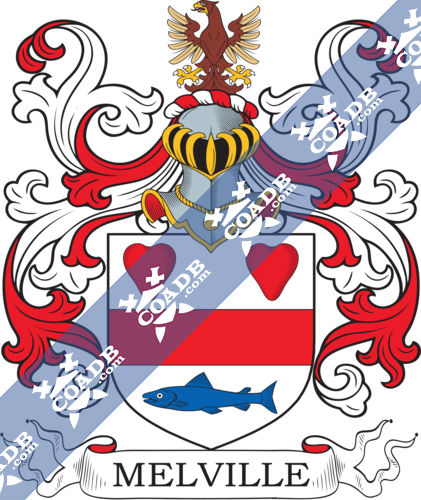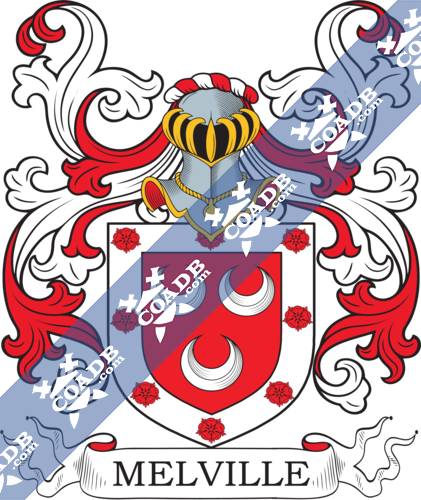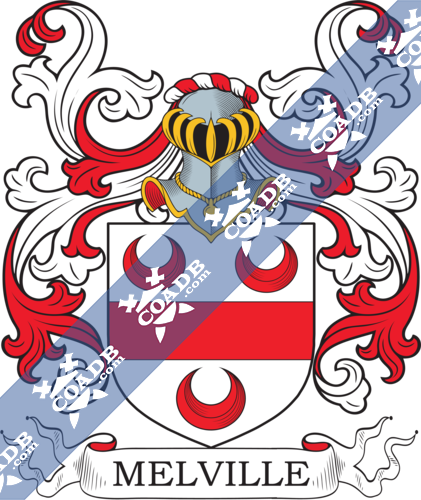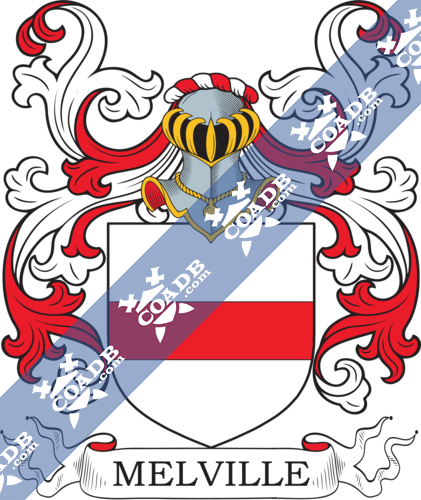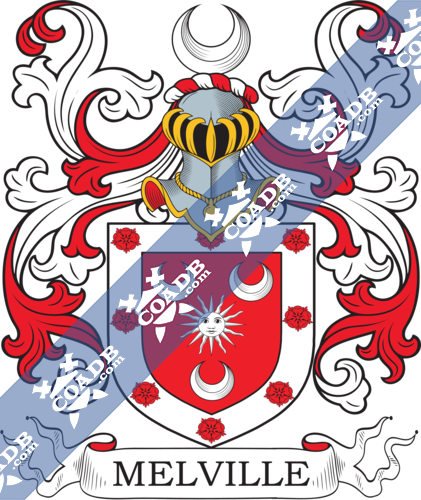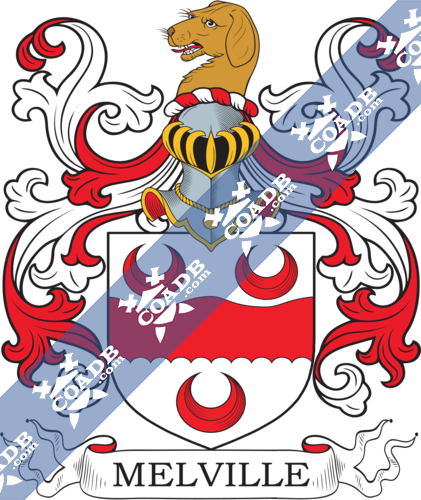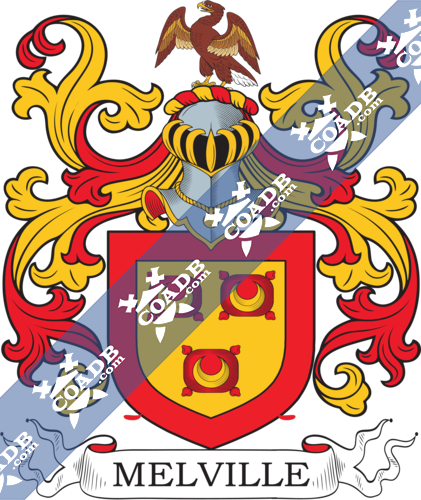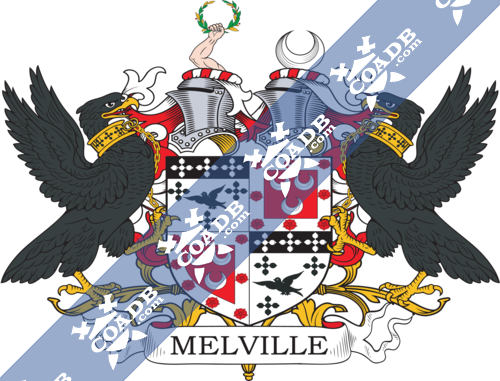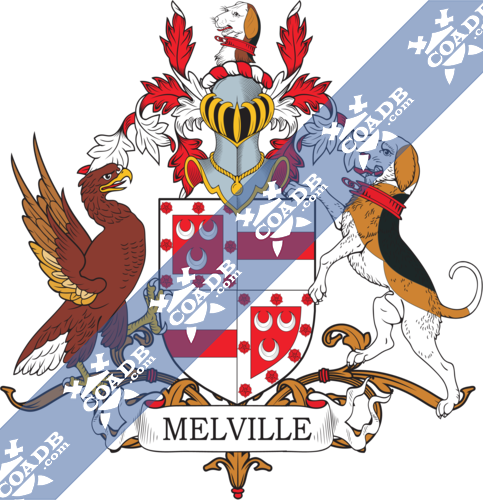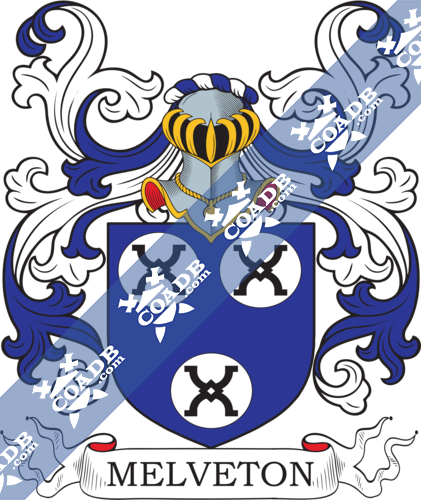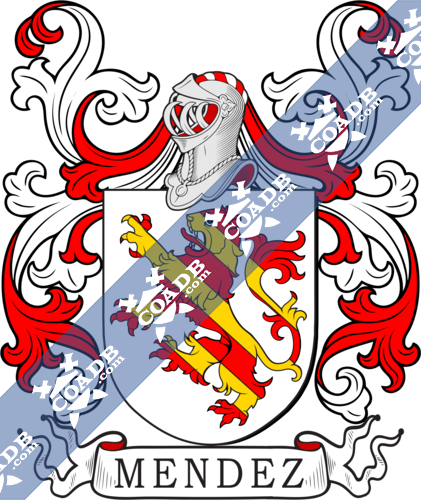Melville Family Crest, Coat of Arms and Name History

Melville Coat of Arms Gallery
Don’t know which Coat of Arms is yours?
We can do a genealogical research. Find out the exact history of your family!
Learn MoreMelville Origin:
France, Scotland
Origin of Melville:
It is fascinating and unique surname which is associated with the local French areas in Normandy known as Malleville, such as Malleville in Pays de Caux. The name derives from the Old French word“mal” which means “poor” or “cheap” indicating to the bad quality of the land or dust in the area, also to the word “Ville” which means “ agreement.” This Norman name brought to Scotland in the 11th Century by the first documented name holder. The areas of Melville in Midlothian, Scotland, further with those in Fife, obtained their name from their first Norman owners. One Hugh de Malleville verified a license near about 1202 in the documents of Paisley Monastery, and in 1296, Sir Richard de Melville bound to promise of faithfulness to the English King, Edward I. In some situations, the name, with different spellings forms as Melvin, Mulveen, and Mulvin, perhaps an Anglicized kind of the Gaelic (O) Maoil Mhin which means “lover of St. Min, from “min,” which means noble.
Variations:
More common variations of this surname are: Mellville, Melaville, Meliville, Melveille, Melhville, Melviille, Melyville, Melvile, Melleville.
Scotland:
The surname Melville first originated in Midlothian. The Melville family lived in this division as early as the mid of 12th century, when King Malcolm IV of Scotland gifted them the estate of Melville in 1160. They are said to have reached in Scotland from Malleville in Pays de Caux, Normandy, where they held the prominent name of the kings of Graville. Another origin is more particular as “The enormous Northern House of Melville declares this Norman as the founder of their race.
The very first recording spelling of the family was shown to be that of Galfridus de (of) Malveill, which dated near about 1161 – 1163, in “settlements of the Holy Cross,” Edinburgh, Scotland. It was during the time of King Malcolm 1V of Scotland, dated 1153 – 1165.
United States of America:
Individuals with the surname Melville settled in the United States in three different centuries respectively in the 17th, 18th, and 19th. Some of the people with the name Melville who settled in the United States in the 17th century included David Melville in America in 1697.
Some of the individuals with the name Melville who settled in the United States in the 18th century included James Melville settled in Granada in 1774.
Some of the individuals with the name Melville who settled in the United States in the 19th century included James Melville, Luke Melville, and Thomas Melville; all these people landed in America in the same year in 1804. Philip Melville at the age of 11, arrived in Allegany (Allegheny) Division, Pennsylvania in 1808. Mary Melville, who landed in Massachusetts in 1812.
Canada:
Some of the people with the name Melville who settled in Canada in the 18th century included Mr. David Melville and Mr. Thomas Melville U.E both settled in Saint Johns, New Brunswick in the same year in 1784.
Australia:
Some of the people with the name Melville who settled in Australia in the 19th century included Henry Melville and Eliza Melville both arrived in Adelaide, Australia aboard the ship “Asia” in the same year in 1851. John Melville arrived in South Australia in 1852 aboard the ship “Medina.” John Melville arrived in South Australia in 1854 aboard the ship “James Fernie.” Ann Melville at the age of 18 arrived in South Australia in 1855 aboard the ship “Aliquis.”
New Zealand:
Some of the people with the name Melville who settled in New Zealand in the 19th century included Jane Melville and J. Melville both arrived in Auckland, New Zealand aboard the ship “Ulcoats” in the same year in 1864. James Melville at the age of 25, Isabella Melville at the age of 23 and Ann Melville, at the age of 11 mths, all these people arrived in the same year in 1865 aboard the ship “Resolute.”
Here is the population distribution of the last name Melville: United States 5,565; England 3,952; Guatemala 1,722; Trinidad and Tobago 991; Guyana 969; Australia 2,815; Scotland 1,877; Canada 1,199; South Africa 3,014; New Zealand 840.
Notable People:
Alexander Gordon Melville (1819-1901), was an Irish anatomist.
Andy Melville (born 1968), was a Welsh football player.
Andrew Melville (1545–1622), was a Scottish philosopher.
Arthur Melville (1858–1904), was a Scottish painter.
Charles Melville (1828-1867), was an American mariner.
Charles B. Melville (FL. 1890-1900s), was an American leader.
Christian Melville (1913-1984), was a Scottish rugby player.
Blazons & Genealogy Notes
1) (England). Ar. a fesse betw. three mascles gu. Crest—A talbot’s head or.
2) (that Ilk, co. Edinburgh; the heiress, in 15th century, mi. Sir John Ross, of Halkhead). Gu. three crescents ar. a bordure of the last, charged with eight roses of the first.
3) (Glenbervie, co.Kincardine; heiress, in 15th century, m. Sir John Auchinleck). Ar. a fess betw. three crescents gu.
4) (Raith, co. Fife). Ar. a fess gu.
5) (Earl of Melville). Motto—Denique coelum. Quarterly, 1st and 4th, gu. three crescents ar. within a bordure of the last, charged with eight roses of the first; 2nd and 3rd, ar. a fess gu. Crest—A ratchhound’s head erased ppr. collared gu. Supporters— Dexter, an eagle volant ppr.; sinister, a ratchbound ppr. collared gu.
6) (Cassingray, co. Fife). Motto—Denique coelo fruar. Quarterly, as Earl of Melville, within a bordure or. Crest—A ratchhound’s head erased ppr. collared gu. the collar charged with a crescent ar.
7) (Murdocairnie, co. Fife, 1672). Motto—Denique coelum. Gu. a sun betw. three crescents ar. within a bordure of the second, charged with eight roses of the first. Crest—A crescent ar.
8) (Auchmoor, co. Fife). Motto—Denique coelum. Ar. on a fesse waved on the upper and engr. on the under side gu. three crescents of the field. Crest—A sleuth-hound’s head couped ppr.
9) (Carnbee, co. Fife). Motto—Ultra aspicio. Or, three cushions gu. on each a crescent of the field, all within a bordure of the second. Crest—An eagle rising ppr.
10) (Strathkinness, co. Fife, 1773). Motto—Denique coelum. Gu. three crescents ar. within a bordure of the last, charged with eight roses of the first, a small crescent of the second in chief for diff. Crest—A crescent ar.
11) (Melville-Whyte). (Bennochy and Strathkinness, co. Fife). Mottoes—Virtute parta; over the second crest: Denique coelum. Quarterly, 1st and 4th, ar. a martlet displ. betw. three quatrefoils, two and one sa. on a chief of the last as many quatrefoils of the first, for Whyte; 2nd and 3rd, gu. three crescents ar. within a bordure of the last charged with eight roses of the field, a crescent for diff., for Melville. Crests— 1st, Whyte: A dexter arm embowed holding up a wreath of laurel all ppr.; 2nd, Melville: A crescent ar. Supporters—Two eagles sa. beaked, membered, collared, and chained or, thereon three quatrefoils sa.
12) (Scotland, 1672). Motto—Denique sursum. Gu. three crescents ar. a bordure invecked of the last, charged with eight roses of the first. Crest—Two eagles’ wings conjoined ppr.
13) (Sir John Melville, Lord Provost of Edinburgh, 1854). Motto—Ad altiora tendo. Ar. a fess gu. betw. two hearts in chief of the second and a salmon naiant in base az. Crest—An eagle rising ppr.

